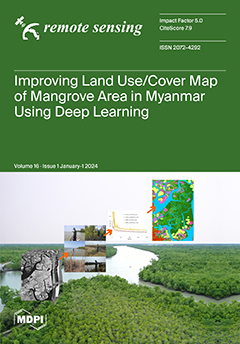Open AccessTechnical Note
Ozone Trend Analysis in Natal (5.4°S, 35.4°W, Brazil) Using Multi-Linear Regression and Empirical Decomposition Methods over 22 Years of Observations
by
Hassan Bencherif, Damaris Kirsch Pinheiro, Olivier Delage, Tristan Millet, Lucas Vaz Peres, Nelson Bègue, Gabriela Bittencourt, Maria Paulete Pereira Martins, Francisco Raimundo da Silva, Luiz Angelo Steffenel, Nkanyiso Mbatha and Vagner Anabor
Cited by 1 | Viewed by 1712
Abstract
Ozone plays an important role in the Earth’s atmosphere. It is mainly formed in the tropical stratosphere and is transported by the Brewer–Dobson Circulation to higher latitudes. In the stratosphere, ozone can filter the incoming solar ultraviolet radiation, thus protecting life at the
[...] Read more.
Ozone plays an important role in the Earth’s atmosphere. It is mainly formed in the tropical stratosphere and is transported by the Brewer–Dobson Circulation to higher latitudes. In the stratosphere, ozone can filter the incoming solar ultraviolet radiation, thus protecting life at the surface. Although tropospheric ozone accounts for only ~10%, it is a powerful GHG and pollutant, harmful to the health of the environment and living beings. Several studies have highlighted biomass burning as a major contributor to the tropospheric ozone budget. Our study focuses on the Natal site (5.40°S, 35.40°W, Brazil), one of the oldest ozone-observing stations in Brazil, which is expected to be influenced by fire plumes in Africa and Brazil. Many studies that examined ozone trends used the total atmospheric columns of ozone, but it is important to assess ozone separately in the troposphere and the stratosphere. In this study, we have used radiosonde ozone profiles and daily TCO measurements to evaluate the variability and changes of both tropospheric and stratospheric ozone separately. The dataset in this study comprises daily total columns of colocalized ozone and weekly ozone profiles collected between 1998 and 2019. The tropospheric columns were estimated by integrating ozone profiles measured by ozone sondes up to the tropopause height. The amount of ozone in the stratosphere was then deduced by subtracting the tropospheric ozone amount from the total amount of ozone measured by the Dobson spectrometer. It was assumed that the amount of ozone in the mesosphere is negligible. This produced three distinct time series of ozone: tropospheric and stratospheric columns as well as total columns. The present study aims to apply a new decomposition method named Empirical Adaptive Wavelet Decomposition (EAWD) that is used to identify the different modes of variability present in the analyzed signal. This is achieved by summing up the most significant Intrinsic Mode Functions (IMF). The Fourier spectrum of the original signal is broken down into spectral bands that frame each IMF obtained by the Empirical Modal Decomposition (EMD). Then, the Empirical Wavelet Transform (EWT) is applied to each interval. Unlike other methods like EMD and multi-linear regression (MLR), the EAWD technique has an advantage in providing better frequency resolution and thus overcoming the phenomenon of mode-mixing, as well as detecting possible breakpoints in the trend mode. The obtained ozone datasets were analyzed using three methods: MLR, EMD, and EAWD. The EAWD algorithm exhibited the advantage of retrieving ~90% to 95% of ozone variability and detecting possible breakpoints in its trend component. Overall, the MRL and EAWD methods showed almost similar trends, a decrease in the stratosphere ozone (−1.3 ± 0.8%) and an increase in the tropospheric ozone (+4.9 ± 1.3%). This study shows the relevance of combining data to separately analyze tropospheric and stratospheric ozone variability and trends. It highlights the advantage of the EAWD algorithm in detecting modes of variability in a geophysical signal without prior knowledge of the underlying forcings.
Full article
►▼
Show Figures





